Showing Spotlights 153 - 160 of 203 in category All (newest first):
 Commercially available supercapacitors store energy in two closely spaced layers with opposing charges and offer fast charge/discharge rates and the ability to sustain millions of cycles. Researchers have come up with various electrode materials to improve the performance of supercapacitors, focussing mostly on porous carbon due to its high surface areas, tunable structures, good conductivities, and low cost. Researchers at KAUST now have developed novel supercapacitor electrodes with remarkable pseudocapacitance. They used a scheme of current collector dependent self-organization of mesoporous cobalt oxide nanowires has been used to create unique supercapacitor electrodes, with each nanowire making direct contact with the current collector.
Commercially available supercapacitors store energy in two closely spaced layers with opposing charges and offer fast charge/discharge rates and the ability to sustain millions of cycles. Researchers have come up with various electrode materials to improve the performance of supercapacitors, focussing mostly on porous carbon due to its high surface areas, tunable structures, good conductivities, and low cost. Researchers at KAUST now have developed novel supercapacitor electrodes with remarkable pseudocapacitance. They used a scheme of current collector dependent self-organization of mesoporous cobalt oxide nanowires has been used to create unique supercapacitor electrodes, with each nanowire making direct contact with the current collector.
Apr 30th, 2012
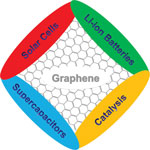 Graphene-based materials are emerging as highly attractive materials for real applications, especially in the area of energy conversion and storage. There are four major energy-related areas where graphene will have an impact: solar cells, supercapacitors, lithium-ion batteries, and catalysis for fuel cells. A recent review gives a brief overview of the recent research concerning chemical and thermal approaches toward the production of well-defined graphene-based nanomaterials and their applications in energy-related areas. But before graphene-based nanomaterials and devices find widespread commercial use, two important problems have to be solved: one is the preparation of graphene-based nanomaterials with well-defined structures, and the other is the controllable fabrication of these materials into functional devices.
Graphene-based materials are emerging as highly attractive materials for real applications, especially in the area of energy conversion and storage. There are four major energy-related areas where graphene will have an impact: solar cells, supercapacitors, lithium-ion batteries, and catalysis for fuel cells. A recent review gives a brief overview of the recent research concerning chemical and thermal approaches toward the production of well-defined graphene-based nanomaterials and their applications in energy-related areas. But before graphene-based nanomaterials and devices find widespread commercial use, two important problems have to be solved: one is the preparation of graphene-based nanomaterials with well-defined structures, and the other is the controllable fabrication of these materials into functional devices.
Apr 18th, 2012
 Ultra- or supercapacitors are emerging as a key enabling storage technology for use in fuel-efficient transport as well as in renewable energy. These devices combine the advantages of conventional capacitors - they can rapidly deliver high current densities on demand - and batteries - they can store a large amount of electrical energy. Today's commercial supercapacitors store energy in two closely spaced layers with opposing charges and offer fast charge/discharge rates and the ability to sustain millions of cycles. Researchers have come up with various electrode materials to improve the performance of supercapacitors, focussing mostly on porous carbon due to its high surface areas, tunable structures, good conductivities, and low cost. In recent years, this has increasingly included research on various carbon nanomaterials such as carbon nanotubes, carbon nano-onions, or graphene. In new work, researchers have demonstrated that a common daily waste - the eggshell membrane - can be converted into a high-performance carbon material for supercapacitors.
Ultra- or supercapacitors are emerging as a key enabling storage technology for use in fuel-efficient transport as well as in renewable energy. These devices combine the advantages of conventional capacitors - they can rapidly deliver high current densities on demand - and batteries - they can store a large amount of electrical energy. Today's commercial supercapacitors store energy in two closely spaced layers with opposing charges and offer fast charge/discharge rates and the ability to sustain millions of cycles. Researchers have come up with various electrode materials to improve the performance of supercapacitors, focussing mostly on porous carbon due to its high surface areas, tunable structures, good conductivities, and low cost. In recent years, this has increasingly included research on various carbon nanomaterials such as carbon nanotubes, carbon nano-onions, or graphene. In new work, researchers have demonstrated that a common daily waste - the eggshell membrane - can be converted into a high-performance carbon material for supercapacitors.
Apr 12th, 2012
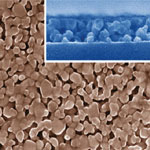 Vanadium dioxide (VO2) has long been recognized as a a material of significant technological interest for optics and electronics and a promising candidate for making 'smart' windows: it can transition from a transparent semiconductive state at low temperatures, allowing infrared radiation through, to an opaque metallic state at high temperatures, while still allowing visible light to get through. So far, VO2 hasn't been considered to be particularly suited for large-scale practical smart-window applications due to its low luminous transmittance and solar modulating ability. Researchers in China have now developed a process that can prepare VO2 thin-films with a controllable polymorph and morphology. Their results show that with increased porosity and decreased optical constants the performance of the VO2 films is enhanced, leading to a higher transmittance of visible light and improved solar modulating ability.
Vanadium dioxide (VO2) has long been recognized as a a material of significant technological interest for optics and electronics and a promising candidate for making 'smart' windows: it can transition from a transparent semiconductive state at low temperatures, allowing infrared radiation through, to an opaque metallic state at high temperatures, while still allowing visible light to get through. So far, VO2 hasn't been considered to be particularly suited for large-scale practical smart-window applications due to its low luminous transmittance and solar modulating ability. Researchers in China have now developed a process that can prepare VO2 thin-films with a controllable polymorph and morphology. Their results show that with increased porosity and decreased optical constants the performance of the VO2 films is enhanced, leading to a higher transmittance of visible light and improved solar modulating ability.
Dec 28th, 2011
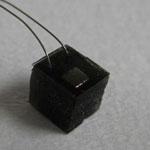 Implantable devices like pace makers or neurostimulators are powered by lithium batteries whose service life is as low as 10 years. Hence, many patients must undergo a major surgery to check the battery performance and replace the batteries as necessary. A team in Japan has now reported an interesting strategy that would keep using batteries but provides a mechanism for remotely recharging them from outside the body by converting laser light into thermal energy and subsequently to electricity. The main purpose of this study was to show that it is possible to remotely control electrical energy generation by laser light that can be transmitted through living tissue in order to target various bionic applications implanted in the body.
Implantable devices like pace makers or neurostimulators are powered by lithium batteries whose service life is as low as 10 years. Hence, many patients must undergo a major surgery to check the battery performance and replace the batteries as necessary. A team in Japan has now reported an interesting strategy that would keep using batteries but provides a mechanism for remotely recharging them from outside the body by converting laser light into thermal energy and subsequently to electricity. The main purpose of this study was to show that it is possible to remotely control electrical energy generation by laser light that can be transmitted through living tissue in order to target various bionic applications implanted in the body.
Dec 20th, 2011
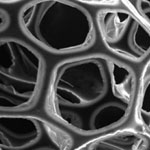 Ultra- or supercapacitors are emerging as a key enabling storage technology for use in fuel-efficient transport as well as in renewable energy. These devices combine the advantages of conventional capacitors - they can rapidly deliver high current densities on demand - and batteries - they can store a large amount of electrical energy. Supercapacitors offer a low-cost alternative source of energy to replace rechargeable batteries. Although the energy density of capacitors is quite low compared to batteries, their power density is much higher, allowing them to provide bursts of electric energy. Researchers have now fabricated novel high-performance sponge supercapacitors using a simple and scalable method. Their results shows that three-dimensional electrodes potentially have a huge advantage over conventional mixed electrode materials.
Ultra- or supercapacitors are emerging as a key enabling storage technology for use in fuel-efficient transport as well as in renewable energy. These devices combine the advantages of conventional capacitors - they can rapidly deliver high current densities on demand - and batteries - they can store a large amount of electrical energy. Supercapacitors offer a low-cost alternative source of energy to replace rechargeable batteries. Although the energy density of capacitors is quite low compared to batteries, their power density is much higher, allowing them to provide bursts of electric energy. Researchers have now fabricated novel high-performance sponge supercapacitors using a simple and scalable method. Their results shows that three-dimensional electrodes potentially have a huge advantage over conventional mixed electrode materials.
Dec 6th, 2011
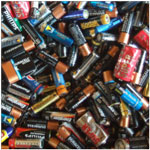 Many batteries still contain heavy metals such as mercury, lead, cadmium, and nickel, which can contaminate the environment and pose a potential threat to human health when batteries are improperly disposed of. Not only do the billions upon billions of batteries in landfills pose an environmental problem, they also are a complete waste of a potential and cheap raw material. Unfortunately, current recycling methods for many battery types, especially the small consumer type ones, don't make sense from an economical point of view since the recycling costs exceed the recoverable metals value. Researchers in India have carried out research to address the recycling of consumer-type batteries. They report the recovery of pure zinc oxide nanoparticles from spent Zn-Mn dry alkaline batteries.
Many batteries still contain heavy metals such as mercury, lead, cadmium, and nickel, which can contaminate the environment and pose a potential threat to human health when batteries are improperly disposed of. Not only do the billions upon billions of batteries in landfills pose an environmental problem, they also are a complete waste of a potential and cheap raw material. Unfortunately, current recycling methods for many battery types, especially the small consumer type ones, don't make sense from an economical point of view since the recycling costs exceed the recoverable metals value. Researchers in India have carried out research to address the recycling of consumer-type batteries. They report the recovery of pure zinc oxide nanoparticles from spent Zn-Mn dry alkaline batteries.
Dec 1st, 2011
 Lithium-ion batteries have been widely used in many electronic devices that are important to our daily life. However, after a steady improvement of some 10-15% during the last two decades, the energy density of lithium-ion batteries is now approaching its theoretical limit set by the energies of cathode and anode materials used in these batteries. Therefore, in recent years, the pursuit of the next generation of energy storage systems has been intense globally. Among various electrochemical energy storage systems explored to date, the lithium-air (Li-air) battery is one of the most promising technologies, with a theoretical energy density nearly ten times that of conventional lithium-ion batteries. A novel air electrode consisting of an unusual hierarchical arrangement of functionalized graphene sheets delivers an exceptionally high capacity.
Lithium-ion batteries have been widely used in many electronic devices that are important to our daily life. However, after a steady improvement of some 10-15% during the last two decades, the energy density of lithium-ion batteries is now approaching its theoretical limit set by the energies of cathode and anode materials used in these batteries. Therefore, in recent years, the pursuit of the next generation of energy storage systems has been intense globally. Among various electrochemical energy storage systems explored to date, the lithium-air (Li-air) battery is one of the most promising technologies, with a theoretical energy density nearly ten times that of conventional lithium-ion batteries. A novel air electrode consisting of an unusual hierarchical arrangement of functionalized graphene sheets delivers an exceptionally high capacity.
Nov 2nd, 2011
 Commercially available supercapacitors store energy in two closely spaced layers with opposing charges and offer fast charge/discharge rates and the ability to sustain millions of cycles. Researchers have come up with various electrode materials to improve the performance of supercapacitors, focussing mostly on porous carbon due to its high surface areas, tunable structures, good conductivities, and low cost. Researchers at KAUST now have developed novel supercapacitor electrodes with remarkable pseudocapacitance. They used a scheme of current collector dependent self-organization of mesoporous cobalt oxide nanowires has been used to create unique supercapacitor electrodes, with each nanowire making direct contact with the current collector.
Commercially available supercapacitors store energy in two closely spaced layers with opposing charges and offer fast charge/discharge rates and the ability to sustain millions of cycles. Researchers have come up with various electrode materials to improve the performance of supercapacitors, focussing mostly on porous carbon due to its high surface areas, tunable structures, good conductivities, and low cost. Researchers at KAUST now have developed novel supercapacitor electrodes with remarkable pseudocapacitance. They used a scheme of current collector dependent self-organization of mesoporous cobalt oxide nanowires has been used to create unique supercapacitor electrodes, with each nanowire making direct contact with the current collector.
 Subscribe to our Nanotechnology Spotlight feed
Subscribe to our Nanotechnology Spotlight feed





